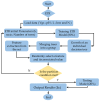Machine Learning-Based Modeling of pH-Sensitive Silicon Nanowire (SiNW) for Ion Sensitive Field Effect Transistor (ISFET)
- PMID: 39771826
- PMCID: PMC11679950
- DOI: 10.3390/s24248091
Machine Learning-Based Modeling of pH-Sensitive Silicon Nanowire (SiNW) for Ion Sensitive Field Effect Transistor (ISFET)
Abstract
The development of ion-sensitive field-effect transistor (ISFET) sensors based on silicon nanowires (SiNW) has recently seen significant progress, due to their many advantages such as compact size, low cost, robustness and real-time portability. However, little work has been done to predict the performance of SiNW-ISFET sensors. The present study focuses on predicting the performance of the silicon nanowire (SiNW)-based ISFET sensor using four machine learning techniques, namely multilayer perceptron (MLP), nonlinear regression (NLR), support vector regression (SVR) and extra tree regression (ETR). The proposed ML algorithms are trained and validated using experimental measurements of the SiNW-ISFET sensor. The results obtained show a better predictive ability of extra tree regression (ETR) compared to other techniques, with a low RMSE of 1 × 10-3 mA and an R2 value of 0.9999725. This prediction study corrects the problems associated with SiNW -ISFET sensors.
Keywords: extra trees regression (ETR); machine learning (ML); multi-layer perceptron (MLP); nonlinear regression (NLR); silicon nanowire ion-sensitive field effect transistor SiNW-ISFET; support vector regression (SVR).
Conflict of interest statement
The authors declare that the research was conducted in the absence of any commercial or financial relationships that could be construed as a potential conflict of interest.
Figures
















Similar articles
-
A Review of Readout Circuit Schemes Using Silicon Nanowire Ion-Sensitive Field-Effect Transistors for pH-Sensing Applications.Biosensors (Basel). 2025 Mar 22;15(4):206. doi: 10.3390/bios15040206. Biosensors (Basel). 2025. PMID: 40277520 Free PMC article. Review.
-
Highly Sensitive and Selective Sodium Ion Sensor Based on Silicon Nanowire Dual Gate Field-Effect Transistor.Sensors (Basel). 2021 Jun 19;21(12):4213. doi: 10.3390/s21124213. Sensors (Basel). 2021. PMID: 34205380 Free PMC article.
-
Process Variability in Top-Down Fabrication of Silicon Nanowire-Based Biosensor Arrays.Sensors (Basel). 2021 Jul 29;21(15):5153. doi: 10.3390/s21155153. Sensors (Basel). 2021. PMID: 34372390 Free PMC article. Review.
-
Improved sensing characteristics of dual-gate transistor sensor using silicon nanowire arrays defined by nanoimprint lithography.Sci Technol Adv Mater. 2017 Jan 6;18(1):17-25. doi: 10.1080/14686996.2016.1253409. eCollection 2017. Sci Technol Adv Mater. 2017. PMID: 28179955 Free PMC article.
-
Silicon nanowire ion sensitive field effect transistor with integrated Ag/AgCl electrode: pH sensing and noise characteristics.Analyst. 2011 Dec 7;136(23):5012-6. doi: 10.1039/c1an15568g. Epub 2011 Oct 10. Analyst. 2011. PMID: 22068238
Cited by
-
A Review of Readout Circuit Schemes Using Silicon Nanowire Ion-Sensitive Field-Effect Transistors for pH-Sensing Applications.Biosensors (Basel). 2025 Mar 22;15(4):206. doi: 10.3390/bios15040206. Biosensors (Basel). 2025. PMID: 40277520 Free PMC article. Review.
-
Smart CAR-T Nanosymbionts: archetypes and proto-models.Front Immunol. 2025 Aug 12;16:1635159. doi: 10.3389/fimmu.2025.1635159. eCollection 2025. Front Immunol. 2025. PMID: 40873579 Free PMC article. Review.
References
-
- Zekentes K., Choi J., Stambouli V., Bano E., Karker O., Rogdakis K. Progress in SiC nanowire field-effect-transistors for integrated circuits and sensing applications. Microelectron. Eng. 2022;255:111704. doi: 10.1016/j.mee.2021.111704. - DOI
-
- Panteli C., Georgiou P., Fobelets K. Performance improvement of commercial ISFET sensors using reactive ion etching. Microelectron. Eng. 2018;192:61–65. doi: 10.1016/j.mee.2018.02.004. - DOI
-
- Artigas J., Jiménez C., Domínguez C., Mínguez S., Gonzalo A., Alonso J. Development of a multiparametric analyser based on ISFET sensors applied to process control in the wine industry. Sens. Actuators B. 2003;89:199–204. doi: 10.1016/S0925-4005(02)00464-1. - DOI
LinkOut - more resources
Full Text Sources

